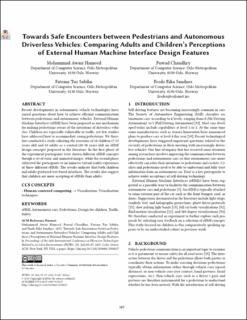Towards Safe Encounters between Pedestrians and Autonomous Driverless Vehicles: Comparing Adults and Children's Perceptions of External Human Machine Interface Design Features
Chapter, Conference object
Published version
Permanent lenke
https://hdl.handle.net/11250/3105676Utgivelsesdato
2023Metadata
Vis full innførselSamlinger
Sammendrag
Recent developments in autonomous vehicle technologies have
raised questions about how to achieve efficient communication
between pedestrians and autonomous vehicles. External Human
Machine Interfaces (eHMI) have been proposed as one mechanism
for making pedestrians aware of the intentions of driverless vehi-
cles. Children are especially vulnerable in traffic, yet few studies
have addressed how to accommodate young pedestrians. We there-
fore conducted a study soliciting the reactions of 10 children (7-15
years old) and 10 adults as a control (20-30 years old) on eHMI
design concepts proposed in the literature. In the first phase of
the experiment participants were shown different eHMI concepts
though a set of static and animated images, while the second phase
subjected the participants to an immerse virtual reality experience
of three different eHMIs. The results indicate that both children
and adults preferred text-based interfaces. The results also suggest
that children are more accepting of eHMIs than adults.

